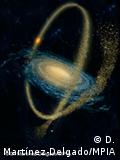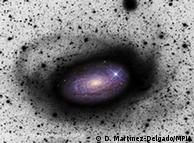SPACE | 13.09.2010
Scientists confirm galactic interaction theory
Scientists at the Max Planck Institute for Astronomy in Germany have just published a new research paper showing empirical evidence to confirm the well-established theory of how spiral galaxies merge with dwarf galaxies.
"When such a small galaxy falls into a large galaxy, it orbits and it gets stretched and eventually dissolved so you expect stream like features or plumes, or clouds to be there around, at a low brightness levels," said Mischa Schirmer, an astronomer at the University of Bonn, in an interview with Deutsche Welle. He was one of the co-authors of the paper, which has been published in the October edition of Astronomical Journal.
The team in Europe and the United States used telescopes in Australia and the United States to observe eight spiral galaxies up to 50 million light-years away, and to find these thin "clouds" in the cosmos.
Schirmer added that there have been no such systematic studies of these kinds of galactic interactions before.
"It sounds a bit funny," he said. "One might think that this is a well-established theory. But because these small galaxies are so faint it's just now in the last few years that we can see them."
As best as astronomers can tell, our own Milky Way galaxy, which is also a spiral galaxy, has absorbed smaller dwarf galaxies much in the same way. But Schirmer also said that the Milky Way is hard to observe, as Earth is well within that galaxy.
"We know that our galaxy has a history of such minor mergers," he said. "But our point of view is that it's a bit different to see what they look like in three dimensions. When you look at a larger distance, you see things more clearly."
 Larger galaxies eventually absorb smaller satellite ones, researchers say
Larger galaxies eventually absorb smaller satellite ones, researchers say
An 'incremental' step
Other scientists in the field say that this confirms empirically what had previously only been established in theory.
"This is an incremental improvement on our understanding of galaxy interaction," said Elias Brinks, a professor of astronomy at the University of Hertfordshire in the United Kingdom in an e-mail to Deutsche Welle.
"The community was already well aware of the importance of mergers among big galaxies, leading to ripples and shells at faint light levels, and that of minor mergers, the interaction of small galaxies and satellite galaxies with larger systems, leading to stellar streams wrapping around the bigger systems."
Other scientists agreed with this assessment.
"I think the result is important because it confirms that tidal streams and substructure produced by merging satellites, a fundamental prediction of the current theory of cosmic structure formation (the so called hierarchical structure formation model), are ubiquitous in galaxies," said Lucio Mayer, a professor of astronomy at the Institute for Theoretical Physics at the University of Zurich, also by e-mail.
"Previously they were observed only in the Milky Way and M31, and in an external galaxy known as the Tadpole galaxy. So it does not change, but rather confirms, the existing scenario of how galaxies form and interact. But again this confirmation, based on exquisite observations of several external galaxies, is important.“
Schirmer added that the next step is to confirm their results by using larger telescopes aimed further into the cosmos.
"We've said that this 50 million light years (distance) is nothing. That's basically what happens today," he said. "The interesting thing is that once we have good statistics on the local volume, and how often do they happen, we want to push the distances. Are there more or less? How does it compare with theory?"
Author: Cyrus Farivar
Editor: Nathan Witkop


No comments:
Post a Comment